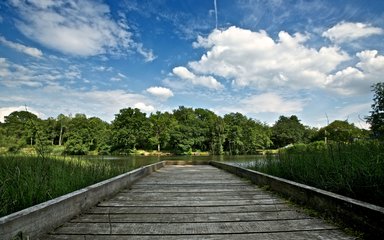Cannop Ponds are classed as reservoirs under the Reservoirs Act 1975. Water leakage through the Lower Cannop dam has been an on-going issue for many decades, creating holes, or voids, within the structure. We have been maintaining and repairing these voids since the 1970s. As custodians of the site, we have a legal obligation to keep the dams safe, and a duty of care for those downstream.
In February 2021 a sinkhole formed next to the spillway wall of Lower Cannop Dam, and so we asked an independent reservoir engineer to carry out an inspection of the dam. This inspection found very significant voids under the spillway. The voids found in 2021 were filled in with concrete, but we realised that this “patch and repair” is not a long-term solution, and does not fix the underlying problem.
Upper and Lower Cannop are classified by the Environment Agency as “high risk”, meaning there is a risk to life should they fail. The failure of both dams would release over 100,000m3 of water downstream.
Further investigations also found that the spillways at both Upper and Lower Cannop were not large enough to cope with extreme rainfall during a storm. More frequent and intense rainstorms are predicted with our changing climate. This leaves the dams in danger of ‘over-topping’, where excess water flows over the top of the dam. Over-topping is a common cause of dam failures worldwide.
The amount of engineering works required to overcome these issues is significant, which is why we began to explore options. The more we looked at what Cannop could be – for the community, for the climate, and for nature – the more the legal obligation to do something began to feel like an opportunity to do some good.
Our commitments
In March 2022 we presented four possible options for the future of Cannop Ponds to the public. All options took into consideration their impact on wildlife, people and the climate. We received over 700 responses and as a result of this feedback we committed to:
Continue working to keep communities safe from a dam failure.
Keep the community informed of the project’s progress.
Use local stone where possible to improve the look of the scheme.
Improve access to the ponds and valley for everyone.
Provide appropriate signage to increase public understanding of local history and wildlife.
Continue to work to moderate storm water flows across the Forest of Dean, to mitigate against extreme rainfall and prolonged droughts.
Narrowing down the options
We spent 2023 gathering as much information as possible to help us make the best decision. We have published every report we have commissioned, to keep people up to date with our progress. These reports can be found in our document library.
In October 2023, we received a report detailing the results of a flood risk modelling exercise which had been carried out. One of the options we were considering was the re-naturalisation of Cannop Brook, but these results showed that this could potentially increase future flood risk. Having already committed to deliver a project that will not cause any worsening of future flood risk, this option was discounted, leaving three remaining options being considered.
Making a decision
Our main objective has always been to make the reservoirs safe. Any solutions which do not address the legal obligations of the Reservoirs Act must be discounted. It is for this reason that doing nothing is not an option.
We also had four additional objectives which have helped us to reach a conclusion on the best solution:
Climate - With storms becoming more frequent and intense due to climate change, the risk of flooding is increasing. We aim to protect the downstream communities from the risk of dam failure and the associated threat of flooding.
Place – We aim to find a solution which keeps a strong sense of place and peaceful destination, which respects the heritage of the valley, and promotes the cultural understanding of Cannop Ponds for future generations.
Nature – The Ponds are known to support a range of wildlife and habitats on both the surrounding land and in the water. We aim to design a solution which benefits the wildlife of the area, enhancing habitats for both native land and water species.
People - Cannop is a popular location both for local people and visitors. We aim to design a solution which will benefit people in the long-term, increasing opportunities for people of all ages and abilities to spend time outdoors.
In January 2024, the Forestry England Executive Board approved our decision, and we started work to make this vision a reality.





